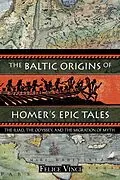Compelling evidence that the events of Homer's Iliad and Odyssey took place in the Baltic and not the Mediterranean
• Reveals how a climate change forced the migration of a people and their myth to ancient Greece
• Identifies the true geographic sites of Troy and Ithaca in the Baltic Sea and Calypso's Isle in the North Atlantic Ocean
For years scholars have debated the incongruities in Homer's Iliad and Odyssey, given that his descriptions are at odds with the geography of the areas he purportedly describes. Inspired by Plutarch's remark that Calypso's Isle was only five days sailing from Britain, Felice Vinci convincingly argues that Homer's epic tales originated not in the Mediterranean, but in the northern Baltic Sea.
Using meticulous geographical analysis, Vinci shows that many Homeric places, such as Troy and Ithaca, can still be identified in the geographic landscape of the Baltic. He explains how the dense, foggy weather described by Ulysses befits northern not Mediterranean climes, and how battles lasting through the night would easily have been possible in the long days of the Baltic summer. Vinci's meteorological analysis reveals how a decline of the "climatic optimum" caused the blond seafarers to migrate south to warmer climates, where they rebuilt their original world in the Mediterranean. Through many generations the memory of the heroic age and the feats performed by their ancestors in their lost homeland was preserved and handed down to the following ages, only later to be codified by Homer in the Iliad and the Odyssey.
Felice Vinci offers a key to open many doors that allow us to consider the age-old question of the Indo-European diaspora and the origin of the Greek civilization from a new perspective.
Autorentext
Felice Vinci is a nuclear engineer with an extensive background in Latin and Greek studies, who has been researching his theory on the northern origin of Greek mythology since 1992. He lives in Rome.
Inhalt
Acknowledgments
Foreword by Joscelyn Godwin
Introduction: The Key to Finding Homer's World
PART ONE: The World of Ulysses
1 Ulysses Homeward Bound: The Island of Ogygia and the Land of Scheria
2 Ithaca's Archipelago: Dulichium, Same, and Zacynthus
3 Ithaca
4 The Adventures of Ulysses
5 Ulysses and Northern Mythology
PART TWO: The World of Troy
6 If "This Is Not the Site of the Ancient Ilium," Where Was Troy?
7 War!
8 Neighboring Lands and Islands
PART THREE: The World of the Achaeans
9 Climate and Chronology: The Northern Origin of the Mycenaeans
10 The Catalog of Ships: The Northern Achaean World
11 The Regions of the Peloponnese
12 Crete, the River Egypt, Pharos, and Phthia
PART FOUR: The Migration of Myth from the Hyperborean Paradise
13 Finding the Home of the Gods
14 Climate Change and the Migration of Culture
15 Solar, Stellar, and Lunar Myths
Conclusion
Appendix: The Bible and the Northern Bronze Age
Notes
Bibliography
Index
